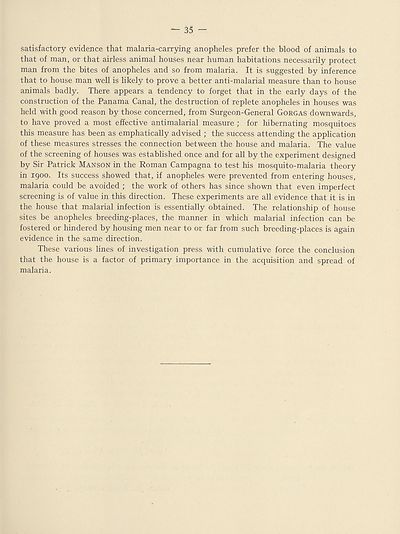Health > Housing and malaria
(37)
Download files
Complete book:
Individual page:
Thumbnail gallery: Grid view | List view

35 -
satisfactory evidence that malaria-carrying anopheles prefer the blood of animals to
that of man, or that airless animal houses near human habitations necessarily protect
man from the bites of anopheles and so from malaria. It is suggested by inference
that to house man well is likely to prove a better anti-malarial measure than to house
animals badly. There appears a tendency to forget that in the early days of the
construction of the Panama Canal, the destruction of replete anopheles in houses was
held with good reason by those concerned, from Surgeon-General Gorgas downwards,
to have proved a most effective antimalarial measure ; for hibernating mosquitoes
this measure has been as emphatically advised ; the success attending the application
of these measures stresses the connection between the house and malaria. The value
of the screening of houses was established once and for all by the experiment designed
by Sir Patrick Manson in the Roman Campagna to test his mosquito-malaria theory
in 1900. Its success showed that, if anopheles were prevented from entering houses,
malaria could be avoided ; the work of others has since shown that even imperfect
screening is of value in this direction. These experiments are all evidence that it is in
the house that malarial infection is essentially obtained. The relationship of house
sites be anopheles breeding-places, the manner in which malarial infection can be
fostered or hindered by housing men near to or far from such breeding-places is again
evidence in the same direction.
These various lines of investigation press with cumulative force the conclusion
that the house is a factor of primary importance in the acquisition and spread of
malaria.
satisfactory evidence that malaria-carrying anopheles prefer the blood of animals to
that of man, or that airless animal houses near human habitations necessarily protect
man from the bites of anopheles and so from malaria. It is suggested by inference
that to house man well is likely to prove a better anti-malarial measure than to house
animals badly. There appears a tendency to forget that in the early days of the
construction of the Panama Canal, the destruction of replete anopheles in houses was
held with good reason by those concerned, from Surgeon-General Gorgas downwards,
to have proved a most effective antimalarial measure ; for hibernating mosquitoes
this measure has been as emphatically advised ; the success attending the application
of these measures stresses the connection between the house and malaria. The value
of the screening of houses was established once and for all by the experiment designed
by Sir Patrick Manson in the Roman Campagna to test his mosquito-malaria theory
in 1900. Its success showed that, if anopheles were prevented from entering houses,
malaria could be avoided ; the work of others has since shown that even imperfect
screening is of value in this direction. These experiments are all evidence that it is in
the house that malarial infection is essentially obtained. The relationship of house
sites be anopheles breeding-places, the manner in which malarial infection can be
fostered or hindered by housing men near to or far from such breeding-places is again
evidence in the same direction.
These various lines of investigation press with cumulative force the conclusion
that the house is a factor of primary importance in the acquisition and spread of
malaria.
Set display mode to:
![]() Universal Viewer |
Universal Viewer | ![]() Mirador |
Large image | Transcription
Mirador |
Large image | Transcription
Images and transcriptions on this page, including medium image downloads, may be used under the Creative Commons Attribution 4.0 International Licence unless otherwise stated. ![]()
| League of Nations > Health > Housing and malaria > (37) |
|---|
| Permanent URL | https://digital.nls.uk/191817979 |
|---|
| Shelfmark | LN.III |
|---|---|
| Description | Over 1,200 documents from the non-political organs of the League of Nations that dealt with health, disarmament, economic and financial matters for the duration of the League (1919-1945). Also online are statistical bulletins, essential facts, and an overview of the League by the first Secretary General, Sir Eric Drummond. These items are part of the Official Publications collection at the National Library of Scotland. |
|---|---|
| Additional NLS resources: |
|

